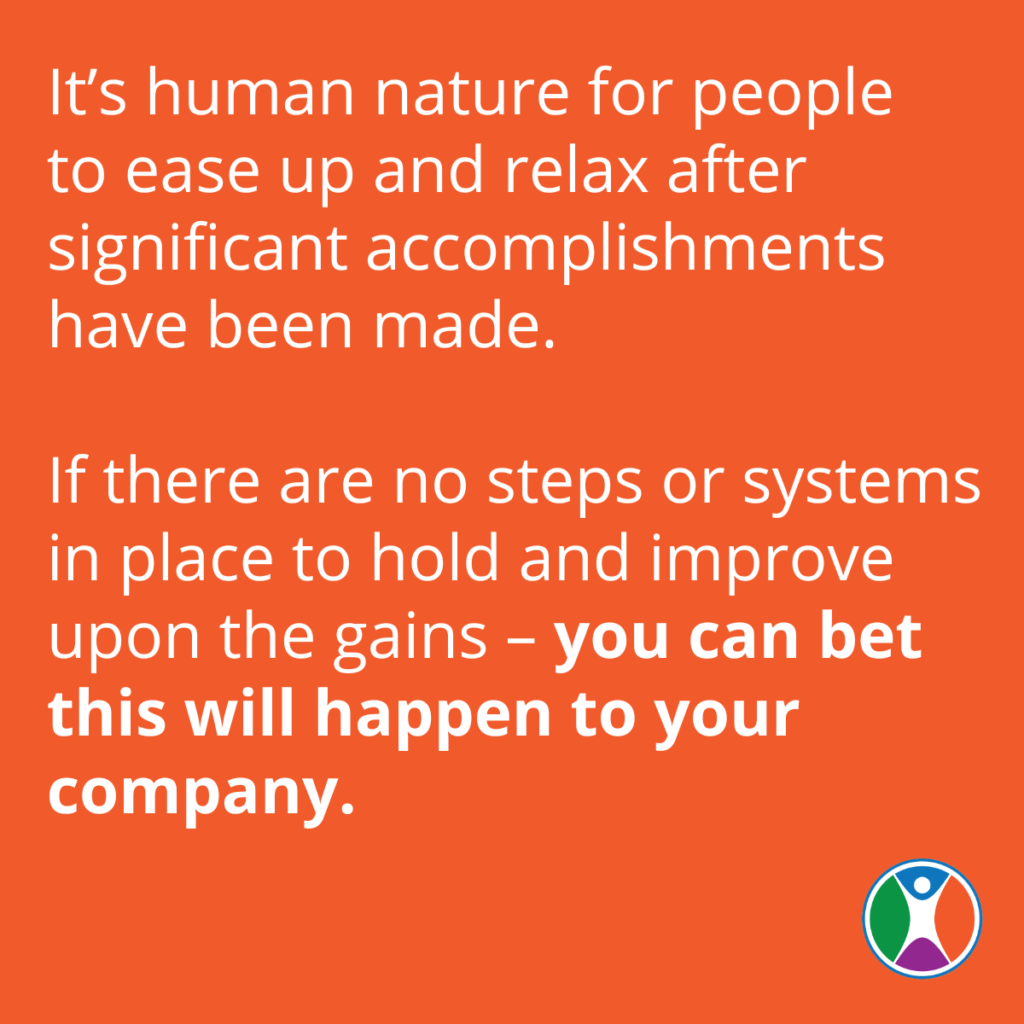It’s not uncommon for teams that have achieved a high level of performance to begin to lose gains over time. In fact, more than 70 percent of organizational change projects fail to meet the projected long-term goals—it’s a reality that many companies experience and don’t even realize why.

One of the first things every manager or business owner needs to understand is that it’s human nature for people to ease up and relax after significant accomplishments have been made. If there are no steps or systems in place to hold and improve upon the gains – you can bet this will happen to your company.
How to take performance to the next level—and sustain those gains.
Establishing a system to regularly evaluate individual and team performance ensures that everyone receives the feedback they need to continually improve the process and sustain high performance results. Without it, gains cannot be sustained, and productivity will naturally atrophy.
Audits—a systematic, consistent way to review and measure the tools and whether your teams are using them the way they’re supposed to.
The audit is a review of teams’ tools and behavior to make sure they’re utilizing the system the way it was intended. It’s not uncommon for some people to use only use the tools they like and to disregard ones that they don’t like or are not comfortable with.
Often, team members who feel less empowered will let a few outspoken coworkers dominate meetings. The audit is to make sure that the system is healthy, and tools are being used and used well. It’s a way to make sure behaviors are reflective of the culture you are trying to establish in your organization.
There are three questions that you ask when conducting an audit:
- Has the tool been created?
- Is the tool being used?
- Is the team acting upon the information?
When auditing the system, there are 10 categories that are addressed. The first five are associated with the tools and infrastructure used by the team. The second five are associated with the behaviors of the team members and their actions.
When you perform the audit, you evaluate these characteristics and calculate a score. Based on the ratings, your score is either sustaining, at risk, or remedial.
The audit questions fall into five categories. You are looking at your team members and evaluating them on the following:
Accountability: Are they taking ownership of their work and are they responsible for the results?
Team dynamics: How well do they communicate, and do these communications produce the desired result?
Supply capacity: What does the team have the capability of doing? Do they understand demand vs supply? Are they spending time on the correct value-added activities or just doing what people ask them to do?
Operational excellence: Are they performing to or above the standard expected of them?
Problem solving: Is the team course correcting where necessary and/or enlisting the help of your problem-solving team?
This audit can be used to look at an individual team’s performance or as a side-by-side comparison of different teams. It also provides an executive summary that shows you the ratings on the 10 categories.
What you get out of an audit:
- Team summaries
- Site summaries
- Executive summaries
Audits are also a way to troubleshoot a team’s leadership
When we work with organizations and perform audits, we watch the team’s behavior. And while this audit is a way to evaluate the team’s performance, it’s also, by default, a way of ranking the supervisor. Because teams will only do what they’re enabled to do by their supervisors and managers.
We can evaluate the supervisor and his ability to manage the team and its processes just by evaluating their team. This is an effective aspect of the audit because the results give us the opportunity to coach the supervisor and/or managers on very specific things they need to work on.
The audit allows us to identify areas where the team is weak and if there is a category (from the audit) where the supervisor or manager needs support or coaching. Maybe they excel at everything except capacity, which they don’t understand or know how to gauge. Whatever areas need work, using this evaluation allows us to work with them to improve their performance, and by default, the team’s performance.
The Dorsey Group’s high-performance framework helps you get results by design, not chance. Continuous performance improvement is a commitment to change—change in the culture and principles of your organization so that people own and are accountable for the results they produce every day.
The Dorsey Group can help unleash your team’s potential and power peak performance. For more information, contact us at www.TheDorseyGroup.org or (954) 629-5774.

